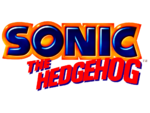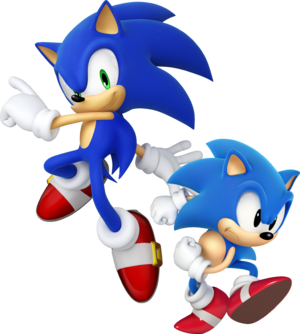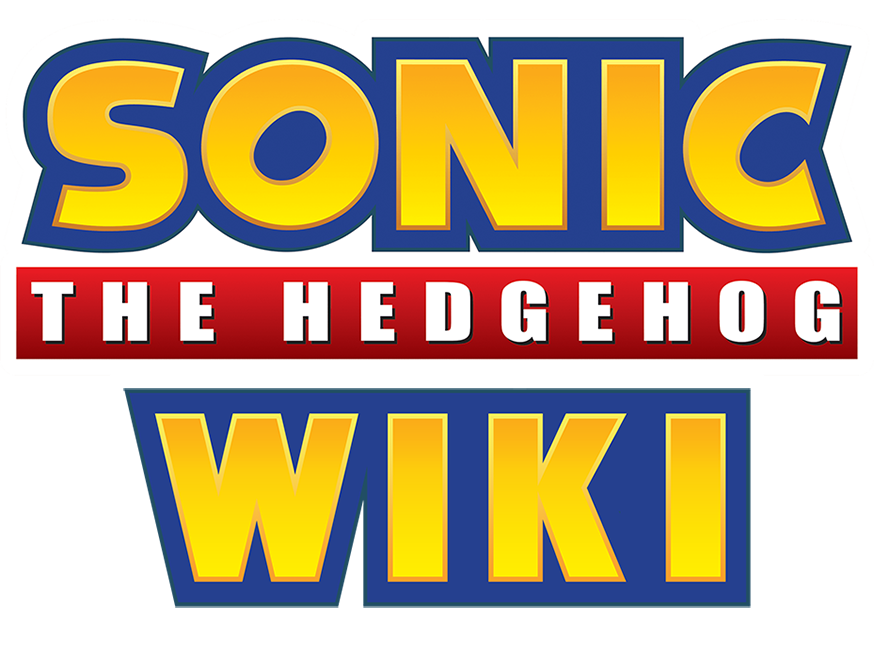Sonic City (talk | contribs) |
Sonic City (talk | contribs) |
||
| Line 105: | Line 105: | ||
=== Development === | === Development === | ||
[[File:Sonic the Hedgehog 281991 29 282013 29 introduction .gif|alt=Opening moments of Sonic the Hedgehog (1991); 2013 remaster. |thumb|Opening moments of Sonic the Hedgehog (1991); 2013 remaster.]] | [[File:Sonic the Hedgehog 281991 29 282013 29 introduction .gif|alt=Opening moments of Sonic the Hedgehog (1991); 2013 remaster. |thumb|Opening moments of Sonic the Hedgehog (1991); 2013 remaster.]] | ||
| Line 118: | Line 119: | ||
=== Franchise === | === Franchise === | ||
{{Main}} | {{Main|Franchise timeline of Sonic the Hedgehog}} | ||
[[Category:Stubs]] | [[Category:Stubs]] | ||
Revision as of 11:56, 21 December 2024
Sonic the Hedgehog (ソニック・ザ・ヘッジホッグ, Sonikku za Hejjihoggu) is a renowned Japanese video game franchise developed and owned by Sega. Created primarily by the company’s Japanese team, including Yuji Naka, Naoto Ohshima, and Hirokazu Yasuhara, the franchise was designed to compete in the video game market, particularly with Nintendo’s iconic mascot, Mario. The core games in the series are platformers, mostly developed by Sonic Team, while spin-offs, typically outsourced to other studios, span a variety of genres. The franchise also includes printed media, animated series, films, and an extensive range of merchandise.
The series began in 1991 with the release of Sonic the Hedgehog for the Sega Mega Drive/Genesis, which provided Sega with its own mascot to rival Mario. The game's success propelled Sega to prominence as a leading video game company in the early 1990s. The subsequent mainline games were developed by the Sega Technical Institute, and several spin-offs were released for the Sega Master System and Game Gear. After a hiatus during the Sega Saturn era, the franchise transitioned into 3D with Sonic Adventure, released in 1998. In 2001, Sega ceased its console production and shifted to third-party development, continuing the series on Nintendo, Xbox, and PlayStation consoles.
The Sonic the Hedgehog series follows the adventures of Sonic, an anthropomorphic blue hedgehog with the remarkable ability to run at superhuman speeds, and his acrobatic spinning attacks. He constantly battles his arch-nemesis, Doctor Eggman, a mad scientist who seeks to take over the world and impose a tech-dominated reality. His schemes often involve the Chaos Emeralds, seven mystical gemstones of limitless power. When combined, the Chaos Emeralds can transform living beings or machines, granting them incredible abilities, including Sonic’s “super transformation,” which allows him to defeat his enemies. The series blends elements of fantasy and science fiction, portraying Sonic as a free-spirited traveler and Eggman as a power-hungry conqueror.
In addition to Sonic, the series features a rich cast of characters, including his loyal sidekick Miles "Tails" Prower, rivals like Knuckles the Echidna and Shadow the Hedgehog, his friend and self-proclaimed girlfriend Amy Rose, and his robotic counterpart Metal Sonic.
Sonic the Hedgehog is Sega’s flagship series and one of the most successful video game franchises in history, with total sales and mobile game downloads surpassing 1.51 billion units by 2022. The original Sonic games are critically acclaimed and frequently listed among the greatest video games of all time. Despite mixed reception to later titles, such as Shadow the Hedgehog, Sonic the Hedgehog (2006), and Sonic and the Secret Rings, the franchise remains influential in the video game industry and continues to make an impact on popular culture.
Logos
| Logo | Years |
|---|---|

|
1991 (US) |

|
1991–1997 (JP) |

|
1992-1997 (US) |

|
1998–present |

|
2001-2004 |

|
2005-2007 |

|
2008–present |
Overview

The Sonic the Hedgehog series primarily revolves around the conflicts between its titular hero, Sonic the Hedgehog, and his arch-nemesis, Dr. Ivo Robotnik, commonly known as "Dr. Eggman". Sonic is a blue hedgehog renowned for his carefree, cool demeanor and his ability to run at supersonic speeds, as well as his signature move of curling into a ball to attack foes [article needed]. Dr. Eggman, on the other hand, is a human mad scientist with an IQ of 300, intent on conquering the world to establish his "Eggman Empire" (or "Eggmanland"), where nature is replaced entirely by machinery.
Rooted in the environmental concerns of the 1990s, the series juxtaposes Sonic, representing "nature," against Eggman, symbolizing "machinery" and "development" [article needed]. This thematic underpinning echoes debates between environmental preservation and industrial progress, making it a key narrative driver of the franchise [article needed].
Central to the series are the Chaos Emeralds, seven mystical gemstones of boundless power [article needed]. The Emeralds can manifest thoughts into power, enabling phenomena like Chaos Control, which manipulates time and space [article needed]. They can also enhance living beings, power machines, and serve as catalysts for destructive devices. Collecting all seven Emeralds allows for a "Super transformation," granting virtual invincibility, enhanced abilities, and immense power [article needed]. These attributes often make the Chaos Emeralds a focal point of Eggman's schemes.
The franchise features an extensive cast of characters introduced across its titles. Key figures include:
- Miles "Tails" Prower: A mechanical prodigy and Sonic's loyal best friend, first appearing in Sonic the Hedgehog 2 (1992).
- Amy Rose: Introduced in Sonic CD (1993), this pink hedgehog wields her Piko Piko Hammer and has an unrequited love for Sonic.
- Metal Sonic: A robotic counterpart to Sonic created by Eggman, debuting in Sonic CD.
- Knuckles the Echidna: Guardian of the Master Emerald on Angel Island, introduced in Sonic the Hedgehog 3 (1993). The Master Emerald controls the Chaos Emeralds' power [article needed].
- Team Chaotix: Introduced in Knuckles' Chaotix (1995), this detective trio includes Vector the Crocodile, Espio the Chameleon, and Charmy Bee.
In transitioning to 3D with Sonic Adventure (1998), the character designs underwent significant changes, featuring sleeker proportions and colored eyes. These updates were retroactively labeled as "Modern" designs, contrasting with the original "Classic" styles [article needed].
Subsequent entries expanded the cast, introducing notable characters such as:
- Shadow the Hedgehog: The "Ultimate Life Form" created by Gerald Robotnik, Eggman's grandfather.
- Rouge the Bat: A treasure hunter and spy working for the United Federation and G.U.N. [article needed].
- Cream the Rabbit: A kind-hearted girl with her Chao companion, Cheese.
- Blaze the Cat: A pyrokinetic princess from the Sol Dimension, guardian of the Sol Emeralds [article needed].
- Silver the Hedgehog: A psychokinetic hedgehog from a dystopian future [article needed].
- The Babylon Rogues: A group of Extreme Gear pilots comprising Jet the Hawk, Wave the Swallow, and Storm the Albatross.
- Infinite: A mercenary wielding the power of the Phantom Ruby [article needed].
- Sage: An artificial intelligence created by Eggman, who refers to him as her father.
Many of these characters have starred in spin-off titles, contributing to the series' enduring legacy.
Two-dimensional (2D) Sonic the Hedgehog titles are side-scrolling platform games viewed from a side-on perspective. Their controls are simple and align closely with traditional platformer standards, but the series' standout feature is the extraordinary speed of its playable characters. Characters can often run up slopes, along walls, and even across ceilings. The primary health system in these games revolves around golden, bracelet-like Rings. As long as a character holds at least one Ring, they are protected from losing a life. Collecting 100 Rings typically grants an extra life (1-Up).
These games are renowned for their momentum-based gameplay, incorporating features like loops and corkscrews. Certain sections propel the character along preset paths with minimal player input, showcasing the series' signature sense of speed. However, the games also include segments requiring precise platforming to navigate hazards such as spikes or bottomless pits, though these challenges are generally less punishing than in other platformers.
Enemies, often called "Badniks," are robots created by Dr. Eggman. They are typically defeated by jumping or rolling into them. Items and power-ups, such as Shields or speed boosts, are hidden in breakable television monitors scattered throughout the stages. Most levels, called Zones, are divided into two or three parts known as "Acts". Star Posts usually serve as checkpoints and may grant access to Bonus Stages if the player collects enough Rings. In 8-bit Sonic games, these checkpoints take the form of Arrow monitors. Acts typically conclude with Goal Plates, while some Zones end with boss battles against more challenging enemies.
Special Stages are a recurring element in the series, often featuring unique gameplay mechanics. These stages are accessible through items like Giant Rings and offer rewards such as Chaos Emeralds, extra lives, and Continues. Chaos Emeralds, in particular, are critical to unlocking additional content or enhanced endings.
In contrast, three-dimensional (3D) Sonic games expand player movement and introduce more complex controls. These entries also include more frequent automated sequences to maintain the series' fast-paced feel. While retaining many of the core elements of 2D games, the 3D titles adjust them for the new perspective, emphasizing plot development and deeper exploration of the characters' stories.
History
Development

Sonic the Hedgehog's creation is attributed to the collaborative efforts of artist Naoto Ohshima, programmer Yuji Naka, and designer Hirokazu Yasuhara.
In April 1990, Sega sought a game that could sell over one million copies, featuring a character capable of rivaling Nintendo's Mario and replacing Alex Kidd as the company's mascot. The AM8 research and development team submitted several character concepts, including an armadillo (later developed into Mighty the Armadillo), a dog, a mustachioed man in pajamas (the basis for Dr. Eggman), and a rabbit with extendable ears for object collection (an idea later used for Ristar). Ultimately, Naoto Ohshima's spiky teal hedgehog, initially code-named "Mr. Hedgehog" and later named Sonic, was chosen. Sonic's color reflected Sega's logo, his shoe design was influenced by Michael Jackson's buckles, and his red shoes drew inspiration from Santa Claus. His personality mirrored the proactive "get it done" attitude associated with Bill Clinton, embodying a modern sensibility of addressing problems promptly. According to Yuji Naka, Sonic's blue hue also symbolized peace, trust, and coolness, aligning with his character traits. Sonic's speed originated from Naka’s habit of completing Super Mario Bros. World 1-1 as quickly as possible. Interestingly, Sonic's inability to swim stemmed from Naka's incorrect belief that hedgehogs couldn’t swim.
A team of 15 developers, later named Sonic Team, began working on the project. Masato Nakamura of the band Dreams Come True composed the soundtrack. Sega promoted the game during the band's "Wonder 3" tour by painting Sonic on the tour bus, distributing promotional materials, and showcasing game footage on stage screens before its release.
Early concept art by Naoto Ohshima portrayed Sonic with fangs and as part of a band, alongside a human girlfriend named Madonna. However, the band was excluded due to time constraints, and Yuji Naka removed Madonna to steer Sonic in a more grounded direction, distinguishing it from the silliness of Super Mario Bros.. Meanwhile, Sega of America, led by Madeline Schroeder, collaborated with Greg Martin to soften Sonic's design for Western audiences, sparking some contention with Sonic Team. Naka later acknowledged that the redesign was likely a beneficial decision.
Sonic's physical attributes, such as age, height, and weight, vary across continuities and artistic styles. In the games, Ohshima's original design featured short spikes, a round body, and no visible irises. Akira Watanabe's artwork, showcasing this version of Sonic, appeared on the packaging for Sonic the Hedgehog. By the release of Sonic the Hedgehog 2, Sonic's proportions shifted, moving from a 1:2 head-to-height ratio to a 1:2.5 ratio.
